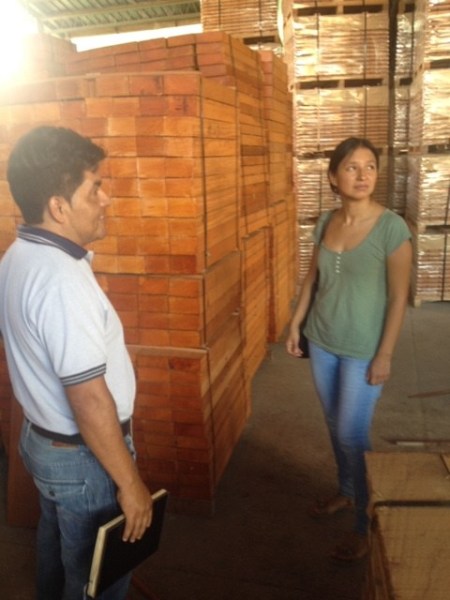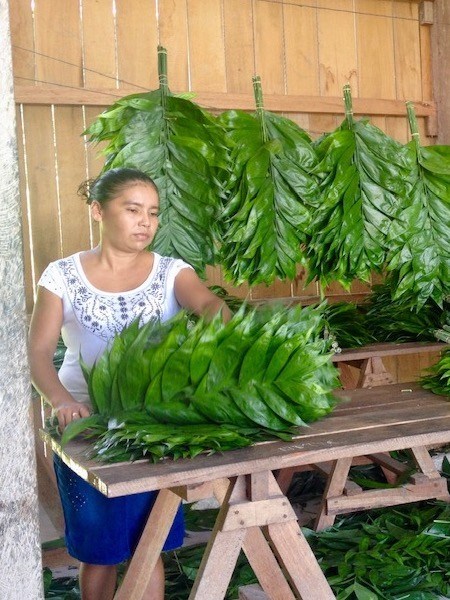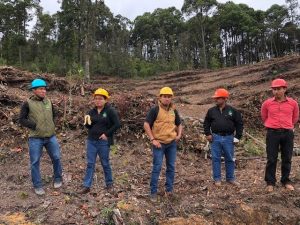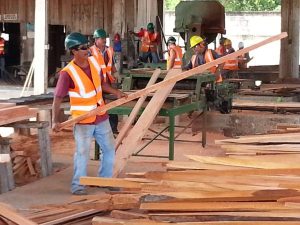Investors can play a crucial role in supporting projects involving the development and restoration of forests, pastures and other natural resources, but the first step for many is to understand and work through the challenges that come with investing in resources managed collectively by a community.
This is where the new Guide to investing in collectively held resources comes in. It draws on experiences in Guatemala, Mexico, Nepal and Namibia – four countries that have among the most successful collective ownership and management arrangements over their natural resources. The first three countries have been devolving forest rights to communities, while Namibia has devolved wildlife rights.
 Ebony boards from trees sustainably produced on community forest concessions on the Mayan Biosphere Reserve, Petén, Guatemala. Photo: Steven Lawry |
 Xate palm fronds, used in floral arrangements, are selected and packaged for export at a community forest concession in the same reserve. Photo: Steven Lawry |
The need for substantial landscape-level investment is huge. It has been estimated that a staggering USD 4.5 trillion per year is required to achieve the Sustainable Development Goals (SDGs). At the same time, investments in land to increase its productivity is seen as one important solution to meet the growing demands for food, fiber and fuel from a rising global population.
The Guide explores ideas and practices for working with community user groups as the principle partners in investment deals and is aimed at so-called “impact investors.” These are often large institutional investors, such as pension funds, with members or shareholders seeking to invest in businesses and organizations with strong environmental and social commitments, while also offering good financial returns.
“Many rural communities really do want private-sector investments in green, sustainable enterprises,” explains Steven Lawry, principal scientist in the Equal Opportunities, Gender, Justice and Tenure division of the Center for International Forestry Research (CIFOR) and co-author of the Guide.
“It is now time for the private sector to begin actively engaging with communities, so they get the support they need to balance environmental social and economic objectives, and over time develop their businesses and access capital with greater efficiency and scale.”
The timing of the publication is no coincidence; it comes as communities are increasingly being given rights by various levels of governments to manage and develop common pool resources – forests, pastures and fisheries – as common property. Examples range from Community Forest Concessions in Guatemala to the ejidos and indigenous communities in Mexico, and from Community Forest User Groups in Nepal to Namibia’s Community-Based Natural Resource Management organizations.

Site of timber harvest at the Capulalpam de Mendes community-owned forest near Oaxaca, Mexico. Photo: Steven Lawry
As governments devolve control down to communities working collectively as “user groups” of their shared resources, local people are gaining control of the landscapes upon which their lives and livelihoods are based.
“Rights give community groups the power to say ‘no’ to any business deal they don’t approve of,” says Lawry. This added measure of autonomy is important because it can lead to negotiations with investors who are interested in accessing and developing local natural resources. But to do so, they must first reach arrangements that are acceptable to everyone involved in the community user groups and learn how best to work with them.
It is essential that all parties to an investment deal understand one another and build mutual trust, says Lawry, which isn’t always easy. There can be preconceptions: investors might be used to a fair amount of certainty and well-managed risk in a deal; community groups might remember bad experiences that trigger hostility toward local or foreign companies, or fear that exposure to outside markets will result in depletion of their resources.
Parties to a deal might also have different definitions of what is a fair sharing of benefits and profits, adds Lawry. “To have a sustainable business partnership, there must be an agreement with the local community to share benefits in a way that is perceived by everyone as being equitable to all those in the community with a stake in the resource. If it is not perceived as equitable, then there is likely to be tension.”
Investors wishing to work with a community to develop its resources might also consider working with a kind of local ‘broker’ or with support organizations that understand local conditions and sensitives, the Guide suggests. It includes an example from Namibia to demonstrate how these local experts can help bring investors and communities together, while assisting with coordination of capacity building, advocacy activities, and information and data collection.

Timber mill owned by a community forest concession in Peten, Guatemala, employs community members. Photo: Dietmar Stoian, ICRAF
The Guide also urges patience as well as thoughtful and cooperative actions in community investments to ensure their sustainability. “It’s essential that such investments respect the rights of local people and protection of the environment,” notes the Guide, which highlights six key lessons for investors interested in common property resources:
- Recognize and respect the social character of community user groups. Develop strong dialogue with the community to build trust and identify NGOs or community support organizations (CSOs) that understand the context.
- Gear up for long-term, sustained effort to help community partners get ready for investment. It takes time to first understand where a community is in terms of readiness, and then see where funds might be most effective.
- Be prepared to invest in capacity building.
- Explore multiple investment mechanisms: from joint ventures (common in Namibia and Mexico, where private-sector partners take some control of day-to-day operations) to blended financing, in which a development bank or donor might assume some first-loss risk on a loan (increasingly seen in Nepal and Guatemala).
- Understand who shapes policy and regulations. Local and regional associations of community user groups can be a wealth of information.
- Integrate environmental standards into the investment, taking into account a community’s environmental standards and social obligations.
“Investments in collectively held resources and community enterprises can provide significant returns – financial, economic, social and environmental,” concludes the Guide. “However, investing in community-held resources often requires longer time frames, greater engagement and communication with community members, support for capacity building and increased transparency.”
Published by CIFOR, the Guide was supported by the CGIAR Research Program on Policies, Institutions, and Markets (PIM). CGIAR is the largest global agricultural innovation network consisting of 15 independent research centers, including CIFOR. In addition to Steven Lawry, its authors include Sophia Gnych, former CIFOR research officer; Iliana Monterroso, CIFOR scientist and gender coordinator; Rebecca McLain, CIFOR senior associate; and Anukram Adhikary, researcher with ForestAction Nepal. Steven Lawry is a co-leader of PIM's research on Governance of Natural Resources.
This blog first appeared on Landscape News of The Global Landscapes Forum (GLF).
Related links:
Governance of Natural Resources research in PIM (video)
Policy seminar: Past, present, and future of the commons
Top image: Lemongrass harvested from the Chisapani Community Forest will be distilled into essential oil and sold. The income made goes back to the community user group. Photo: Chandra Shekhar Karki, CIFOR

